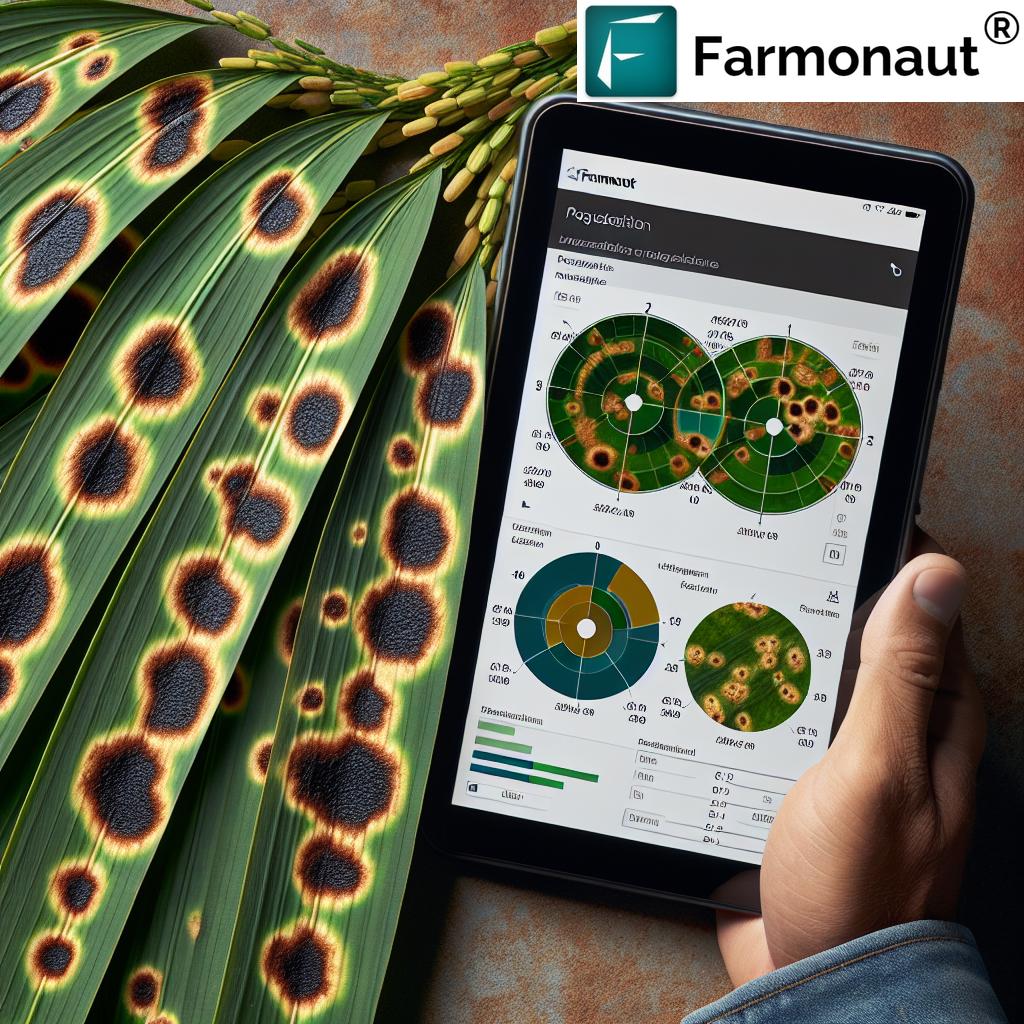Yield Optimization: 7 Shocking Hacks for Bigger Harvests
Table of Contents
- Introduction: The Urgency and Opportunity in Yield Optimization
- Shock #1: Precision Agriculture Technologies Transforming Modern Farming
- Shock #2: Crop Rotation and Diversification for Soil Health
- Shock #3: Soil Management—The Gamechanger for Sustainable Yields
- Shock #4: Integrated Pest Management—Biology Beats Chemicals
- Shock #5: Smart Irrigation Systems Redefine Water Efficiency
- Shock #6: High-Yield Varieties Outperform Traditional Seeds
- Shock #7: Controlled Environment Agriculture for Predictable, Profitable Crops
- Comparative Impact Table: The 7 Yield Optimization Hacks
- Further Technologies Driving Yield Optimization
- Yield Optimization Benefits: Why Modern Farms Can’t Ignore It
- Advanced Water Strategies: Deficit Irrigation & AWD
- Forestry Yield Optimization: Rotation Ages & Timber Management
- How Farmonaut Empowers Yield Optimization Globally
- Frequently Asked Questions
- Conclusion: The Future of Yield Optimization in Agriculture
“Precision agriculture can increase crop yields by up to 20% using data-driven decisions and targeted resource application.”
Introduction: The Urgency and Opportunity in Yield Optimization
Yield optimization in agriculture, farming, and forestry is not just a buzzword— it’s the backbone of feeding our growing population while safeguarding the environment. As resource scarcity, climate variability, and economic pressures intensify, we must turn to technology, data insights, and sustainable systems to drive improved crop yields and farm profitability.
Our modern challenge is twofold: improving productivity while maintaining environmental sustainability. The solution? A holistic approach that blends precision agriculture technologies, smart irrigation systems, robust pest management, and resilient crop management practices.
By integrating advanced technologies, efficient resource allocation, and sustainable farming practices, we can deliver higher yields, better economic returns, and healthier ecosystems.
In this comprehensive guide, we reveal seven shocking hacks for yield optimization—each backed by real science, state-of-the-art technology, and actionable strategies for both smallholder farmers and large agribusinesses.
Shock #1: Precision Agriculture Technologies Transforming Modern Farming
Focus Keyword: Precision Agriculture for Yield Optimization
Precision agriculture is the cornerstone of modern yield optimization in agriculture. By leveraging cutting-edge GPS mapping, IoT sensors, drones, and advanced data analytics, we can monitor and manage crops at an unprecedented level of accuracy.
- IoT sensors gather real-time data on soil moisture, nutrient levels, and weather patterns, letting us optimize irrigation and fertilizer application.
- Drones and satellite imagery (like those provided via Farmonaut’s platform) help us identify problem areas, conduct targeted interventions for pests or diseases, and optimize resource use.
- AI-powered advisory systems predict crop cycles, disease outbreaks, and optimal harvesting conditions, providing actionable intelligence for decision-making.
By applying the right amount of water, fertilizers, and pesticides—exactly when and where needed—we drastically reduce resource waste and boost productivity.
Farmonaut’s satellite-based crop monitoring and AI-driven insights offer affordable, scalable, and data-rich solutions so every farmer—from large agribusinesses to small landowners—can achieve higher yield and efficient resource management in farming.
Explore Farmonaut’s Large-Scale Farm Management tools to monitor extensive plantations, optimize input usage, and improve overall farm efficiency leveraging satellite and AI solutions.
Shock #2: Crop Rotation and Diversification for Soil Health
Focus Keyword: Crop Rotation and Diversification Strategies
Too often, repeated cultivation of a single crop leads to soil nutrient depletion and increased pest pressure—slashing the potential yield and threatening food security. The answer? Crop rotation and diversification.
- Alternating crop types (e.g., rotating legumes with cereals) allows nutrient cycles to replenish, improving soil structure and biological diversity.
- Diversification dilutes pest and disease cycles, limiting chances for pests to adapt and reducing the need for chemical inputs.
- Mixing crops enhances resilience to weather swings and market fluctuations—keeping farm incomes and yields stable.
Through strategic crop rotations and planting a variety of species, we can rejuvenate soil fertility, manage pests naturally, and adapt to environmental change—all hallmarks of sustainable farming practices.
Get personalized rotation and diversification insights in Farmonaut’s advisory platform, empowering you with data-backed plans for better yields and healthier soils.
Shock #3: Soil Management—The Gamechanger for Sustainable Yields
Focus Keyword: Soil Fertility Management
Healthy, living soil is the engine of any productive farm. Effective soil management strategies not only boost crop yields but also protect against erosion, leaching, and nutrient loss. Our approach includes:
- Cover cropping: Planting off-season crops that shield topsoil, fix nitrogen, and enhance organic matter.
- Reduced tillage systems: Minimizing soil disturbance to preserve soil structure, moisture retention, and beneficial soil organisms.
- Organic amendments: Incorporating compost, manure, and biochar for improved fertility, water retention, and microbial health.
Integrated soil management practices not only lift yields, but also future-proof our farms against drought, heavy rains, and market changes, solidifying overall resilience.
Measure and monitor your soil’s carbon footprint with Farmonaut—track your environmental impact, demonstrate sustainability, and unlock new opportunities for eco-certification.
Shock #4: Integrated Pest Management—Biology Beats Chemicals
Focus Keyword: Integrated Pest Management (IPM) in Farming
Pests and diseases are a perennial threat to crop health and productivity. Excessive use of chemical pesticides leads to resistance, environmental harm, and rising input costs. Integrated Pest Management (IPM) reshapes the approach by combining:
- Biological controls—introducing natural predators, parasitoids, and beneficial organisms to keep pests in check.
- Cultural practices—using crop rotations, clean field practices, and precise timing to disrupt pest and disease cycles.
- Mechanical controls—physical removal, barriers, and traps for effective pest management.
- Targeted, minimal chemical use—only when necessary, and based on monitoring and threshold identification.
By integrating IPM strategies, we sustain higher yields, maintain crop quality, and minimize negative environmental impact.
“Smart irrigation systems can reduce water usage by 30% while maintaining or improving crop productivity in modern farms.”
Shock #5: Smart Irrigation Systems Redefine Water Efficiency
Focus Keyword: Smart Irrigation Systems & Water Management
Globally, water scarcity and inefficient irrigation drain farm profits and degrade farmland. Modern smart irrigation systems (SIS)—like drip irrigation, automated sprinklers, and IoT-powered soil moisture controls—enable us to precisely manage when and how much water crops receive.
- IoT-based sensors give us continuous, real-time soil moisture data to schedule irrigation accordingly.
- Automated drip and sprinkler systems drastically reduce water waste, improve nutrient uptake, and limit disease by reducing leaf wetness.
- AI integration—like Farmonaut’s weather-adaptive irrigation advice—ensures optimal application based on crop growth stage and weather predictions.
Studies show smart irrigation systems can cut water usage by up to 30% while improving crop yields, helping us future-proof against droughts and water supply shocks.
Leverage satellite-based crop monitoring for insurance and loan eligibility on smart-irrigated fields with Farmonaut—reduce financial risk and build resilience.
Shock #6: High-Yield Varieties Outperform Traditional Seeds
Focus Keyword: High-Yield Crop Varieties
Emit more with less: High-yield, hybrid, or genetically improved seed varieties are specially engineered for higher productivity, better resilience to diseases, pests, and extreme weather, and improved nutrient use efficiency.
- Greater yields per acre without proportionately more inputs.
- Built-in resistance to biotic stresses (like pests or diseases) and abiotic stresses (like heat or drought).
- Faster maturity cycles aligning with regional market demand and environmental conditions.
Adopting high-yield varieties allows both traditional and modern farmers to maximize land use and achieve stellar returns on investment, driving global agricultural progress.
Shock #7: Controlled Environment Agriculture for Predictable, Profitable Crops
Focus Keyword: Controlled Environment Agriculture (CEA)
- Year-round production and supply independent of seasonal or climate changes.
- Higher yields per square meter and consistent quality due to managed inputs.
- Reduced pest/disease risk—often eliminating the need for chemical pesticides entirely.
- Significant water savings compared to open field cultivation (efficiency leaps in urban areas or water-scarce regions).
CEA is a disruptor—helping us meet global food demand, urbanize agriculture, and bolster food security even in the face of climate and resource volatility.
Access satellite-powered remote monitoring for greenhouses and CEA facilities through Farmonaut for instant crop updates and actionable insights.
Comparative Impact Table: The 7 Yield Optimization Hacks
| Hack/Technique | Technology/Practice Used | Estimated Yield Increase (%) | Estimated Implementation Cost (USD/acre) | Complexity Level | Environmental Impact |
|---|---|---|---|---|---|
| Precision Agriculture | GPS, IoT Sensors, Drones, AI | 10-20% | $20-50 | Medium | Positive |
| Crop Rotation & Diversification | Alternating/Multiple Crops | 8-12% | $2-8 | Low | Positive |
| Soil Management | Cover Cropping, Tillage, Organics | 7-15% | $10-25 | Medium | Positive |
| Integrated Pest Management (IPM) | Biological/Cultural/Mechanical Controls | 5-10% | $8-20 | Medium | Positive |
| Smart Irrigation | Drip, Sprinklers, IoT Automation | 8-16% | $18-35 | Medium | Positive |
| High-Yield Varieties | Hybrid/Genetically Improved Seeds | 12-25% | $12-28 | Low | Positive |
| Controlled Environment Agriculture | Greenhouse/Vertical Farm Systems | 18-35% | $30-250 | High | Positive |
Further Technologies Driving Yield Optimization in Agriculture
The seven hacks we’ve detailed draw on an expanded ecosystem of innovative tools and methods. Here’s how technology amplifies productivity, precision, and resilience in modern farming:
- IoT Sensors: Critical for real-time soil and crop monitoring, these sensors automate water and fertilizer application, cut costs, and enable precision interventions.
- Drones: Swiftly monitor large fields, detect diseases, pests, and stress patterns, and guide us in rapid response actions.
- Artificial Intelligence: Integrates satellite data, weather predictions, and crop cycles to suggest optimal planting schedules and manage risks efficiently.
- Blockchain Traceability: Ensures complete transparency from farm to consumer, offering traceability solutions that improve consumer trust and product value.
- Autonomous Machinery: Boosts operational speed and efficiency—self-driving tractors and harvesters cut labor costs and guarantee timely crop management.
For developers, businesses, and researchers seeking seamless integration of yield optimization data, the Farmonaut API and API Developer Docs provide robust access to satellite, weather, and crop management data for scalable resource management solutions.
Yield Optimization Benefits: Why Modern Farms Can’t Ignore It
- Increased Productivity: Achieve dramatically higher output per acre—crucial for meeting food security and profitability goals.
- Cost Efficiency: Use only what’s needed—irrigation, fertilizer, labor—all through precision resource management and data-driven decision-making.
- Environmental Sustainability: Slash water, chemical, and input waste—restoring ecosystems and reducing greenhouse gas emissions.
- Improved Crop Quality: Healthier plants, consistent yields, and superior nutritional or market value.
- Resilience to Change: Prepare for climate volatility, resource scarcity, and global market shifts with adaptive, sustainable farming systems.
By weaving these practices together, we transition from reactive to proactive farming—delivering better yields, lower costs, and safer food systems for the future.
Advanced Water Strategies: Deficit Irrigation & AWD Methods
Water efficiency is a defining challenge for the world’s farms, particularly in arid and semi-arid landscapes.
- Deficit Irrigation: This refined irrigation strategy means only supplying water during drought-sensitive phases of crop growth—deliberately withholding it during less critical stages. By aligning water supply with crop water productivity (instead of just maximizing yield), we reduce overall water usage and cost, a must in regions facing scarcity.
- Alternate Wetting and Drying (AWD): For rice and similar crops, AWD periodically dries and then re-floods paddies—cutting up to 38% of irrigation water use, reducing greenhouse gas emissions, and still maintaining robust yields. AWD also offers firmer, easier-to-harvest fields, slashing labor and mechanical harvesting costs.
With remote monitoring from platforms like Farmonaut, farmers can optimize their irrigation cycles in real-time and maximize returns on water investments.
Tip: Use Farmonaut’s satellite datasets to monitor soil moisture trends and water stress for timely irrigation adjustments.
Forestry Yield Optimization: Rotation Age & Sustainable Timber Management
Yield optimization is just as vital in forestry as it is in crop farming. For timber, we focus on the optimal rotation age—the point where we get maximum economic or biological return from a stand of trees.
- Economic Rotation: Determined by maximizing net present value (NPV) of timber revenue after factoring in costs of replanting, harvesting, and market cycles.
- Biological Rotation: Based on the mean annual increment (MAI)—the point at which annual average timber volume peaks, signaling sustainable, renewable yield.
Modern forest plantations use satellite and drone monitoring (as with Farmonaut’s plantation advisory services) to track stand health, growth rates, and predict optimal harvest windows.
- Balance short-term profit with long-term sustainability.
- Optimize replanting and yield cycles for climate and market changes.
Bringing precision resource management to forestry is crucial for maximizing economic returns and conserving global forest resources.
How Farmonaut Empowers Yield Optimization Globally
Farmonaut stands at the forefront of the agriculture technology revolution—making precision agriculture simple, affordable, and accessible for everyone. Our platform delivers advanced satellite-powered crop health monitoring, actionable AI-based advisory, blockchain traceability, and resource management tools—right on your mobile or web device.
- Real-time monitoring—track vegetation health, soil moisture, and more with satellite imagery for data-driven decision making.
- Jeevn AI-based personalized advisory—get tailored, regionally-adapted recommendations on resource management in farming and yield optimization strategies.
- Blockchain for product traceability—ensure transparent, reliable traceability solutions for agricultural supply chains.
- Fleet and resource management—enhance cost control and operational fleet efficiency across large farms and agribusinesses.
- Carbon footprinting—measure and manage your environmental carbon impact, paving the way for sustainable certifications.
- API and Data Integration—integrate Farmonaut’s solutions for scalable, automated agricultural and forestry monitoring (API Here / Developer Docs).
Start your yield optimization journey with Farmonaut—no special hardware needed, just actionable insights and easy implementation for everyone.
Frequently Asked Questions about Yield Optimization in Agriculture
-
What is yield optimization in agriculture?
Yield optimization in agriculture is the strategy of maximizing crop productivity and economic returns through a blend of advanced technologies, data-driven resource management, and sustainable practices. It focuses on increasing yield per acre, minimizing input waste, and preserving environmental sustainability.
-
How does precision agriculture help improve crop yields?
Precision agriculture employs GPS, IoT sensors, drones, and AI to monitor soil and crop conditions in real time, automate irrigation and fertilizer application, and proactively manage pests and diseases. These data-driven interventions optimize every aspect of farming for higher yields and lower costs.
-
Can smallholder farmers benefit from these technologies?
Absolutely. Solutions like Farmonaut’s satellite-based platform make precision agriculture affordable and accessible for small and medium-sized farms without the need for expensive hardware. Tailored advisory services and resource management tools help all farmers boost productivity and profits.
-
What are some sustainable farming practices included in yield optimization?
Key practices include crop rotation, soil fertility management, integrated pest management, organic amendments, and water-efficient irrigation methods (like deficit and alternate wetting-and-drying). These preserve natural resources and build resilience to climate and market changes.
-
How does controlled environment agriculture (CEA) work?
CEA refers to growing crops in managed indoor systems such as greenhouses or vertical farms, where all variables—light, water, nutrients, temperature, humidity—are optimized for yield and consistency, regardless of outdoor weather.
-
Where can I access the Farmonaut platform?
Access Farmonaut via Web, Android, or iOS. For large agribusiness, NGOs, or developer integration, see Farmonaut API and Developer Docs.
-
Is Farmonaut a marketplace or farm input supplier?
No, Farmonaut does not sell farm inputs, machinery, or operate as a regulatory body or marketplace. It is a precision agriculture technology provider offering satellite-based monitoring, AI-advisory, blockchain traceability, and resource management services.
Conclusion: The Future of Yield Optimization in Agriculture
Yield optimization is no longer an option—it’s an imperative for farmers, agribusinesses, and food systems worldwide. By integrating precision agriculture technologies, smart resource management, and sustainable practices, we unlock new frontiers in crop productivity, profitability, and environmental stewardship.
With tools like Farmonaut’s real-time monitoring and AI-driven analytics, we can:
- Identify problem areas and optimize inputs for maximum return.
- Address soil fertility, pest cycles, and climate risks with actionable, science-based strategies.
- Drive forward sustainable farming practices that offer lasting resilience and value to communities and the planet.
The technology is here, the need is urgent, and the opportunity is boundless. Start optimizing your yield—join Farmonaut today and make every acre count.






















